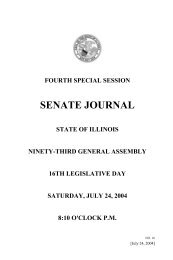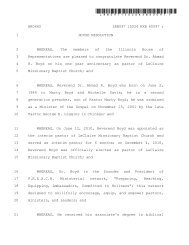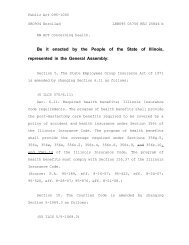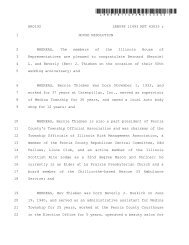Long-Term Care - Illinois General Assembly
Long-Term Care - Illinois General Assembly
Long-Term Care - Illinois General Assembly
You also want an ePaper? Increase the reach of your titles
YUMPU automatically turns print PDFs into web optimized ePapers that Google loves.
folks are looking at other kinds of options, particularly when you're able to provide some<br />
residential options.<br />
• There are also community-based service development funds. The legislature provided<br />
$6 million a year to expand community-based services. One of the major areas and<br />
interests of the State was providing much more housing and service options, including<br />
affordable housing and assisted living services. We had very few assisted living<br />
opportunities for individuals that were participating in the waiver programs. More assisted<br />
living services offer the best substitute for nursing home care in terms of providing<br />
assistance for individuals with medication management problems and dementia problems.<br />
Money was provided for nursing homes for capital projects to re-configure wings to provide<br />
assisted living services, daycare services and other home and community-based services --<br />
essentially trying to encourage the industry to get into the home and community-based<br />
marketplace.<br />
• Minnesota also increased funding of the elderly waiver and alternative care programs.<br />
Significant dollars were reinvested into these particular programs based on projections and<br />
forecasts of the number of facilities that would voluntarily come forward to close beds. The<br />
state estimated that about 5,000 beds in Minnesota would close during the 2-year biennium,<br />
and the dollars saved would be used to finance assisted living and diversification projects.<br />
• The task force developed an incentive for voluntary nursing home bed closures. There was<br />
a need to guard against beds leaving the market where there was a need in the system, and<br />
where there were projections based on the “2030” demographer that indicated a need for<br />
beds in the future. There was a need for careful investment in building the nursing home<br />
stock in the system. This is a voluntary system, which helped in getting it passed through<br />
the legislature. Facilities were not told: “You have to come forward.” Incentives were<br />
provided to come forward. The incentive was $2,080 for each closed bed. That amount<br />
would be moved into a home’s base rate. So, some of the savings went back to the<br />
facilities, while other dollars were moved into investments in the long-term care system,<br />
including cost-of-living adjustments for both nursing homes and home and community-based<br />
service providers. That was really important, because we had been more generous with<br />
cost of living adjustments for nursing homes than for home and community-based services.<br />
The incentive program cost approximately $8 million<br />
• There were also proposals and initiatives to further strengthen the long-term care workforce.<br />
Dollars were provided to facilities interested in providing scholarships to their workers to<br />
advance in long-term care. The conditions required the workers to stay in long-term care for<br />
a set amount of time. The State provided participating facilities additional revenues on a per<br />
bed basis to develop scholarship programs to send nurse's aides to LPN, or RN training to<br />
help them advance careers and hopefully keep them in long-term care.<br />
• Initiatives were also added to enhance quality and consumer satisfaction. The idea in this<br />
case is to establish report cards on nursing facilities and also on home and<br />
community-based service providers.<br />
• What would a long-term care reform proposal have without somebody designing a long-term<br />
care payment system? This is a process that actually has been on hold. The goal is<br />
provide reimbursements based on quality of care. That is now on hold. It will be moving<br />
more toward a simplified reimbursement system, for which details are not currently<br />
available.<br />
24
















